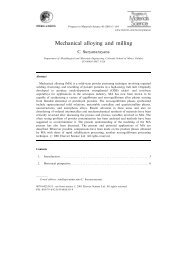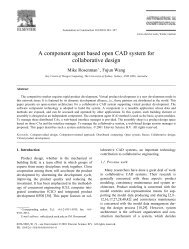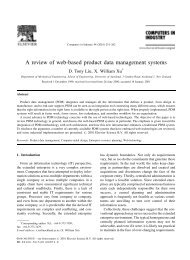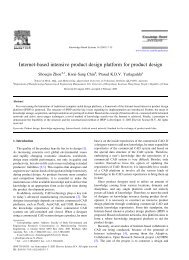Just-in-time purchasing: An investigation for research and ... - GRACO
Just-in-time purchasing: An investigation for research and ... - GRACO
Just-in-time purchasing: An investigation for research and ... - GRACO
Create successful ePaper yourself
Turn your PDF publications into a flip-book with our unique Google optimized e-Paper software.
80 A. Gunasekaran/Int. J. Production Economics 59 (1999) 77—84<br />
size, reductions <strong>in</strong> the number of motor carriers<br />
used, <strong>and</strong> decreas<strong>in</strong>g lead <strong>time</strong>s are all prevalent<br />
tendencies. In most of these areas, firms which have<br />
implemented JIT are evolv<strong>in</strong>g at a faster pace than<br />
non-JIT companies. Also, although paper work<br />
cont<strong>in</strong>ues to <strong>in</strong>crease, JIT users are experienc<strong>in</strong>g<br />
less of an <strong>in</strong>crease than non-JIT users. There are<br />
noticeable changes <strong>in</strong> the structure of the purchas<strong>in</strong>g<br />
organization as well. Increased communications<br />
with other functional areas <strong>and</strong> suppliers are<br />
common. Furthermore, many purchas<strong>in</strong>g departments<br />
are view<strong>in</strong>g suppliers as strategic partners<br />
<strong>and</strong> are act<strong>in</strong>g accord<strong>in</strong>gly. The number of suppliers<br />
per firm is be<strong>in</strong>g reduced. Suppliers are also<br />
accept<strong>in</strong>g longer contracts are mak<strong>in</strong>g valuable<br />
suggestions, <strong>and</strong> are be<strong>in</strong>g recruited as members<br />
of product design <strong>and</strong> cont<strong>in</strong>uous improvement<br />
teams [13].<br />
Herbig <strong>and</strong> O’Hara [14] show how partnerships<br />
are critical to the success of JIT purchas<strong>in</strong>g on<br />
which competitive ability so often depends. The<br />
<strong>research</strong> concludes that partnerships will cont<strong>in</strong>ue<br />
to <strong>in</strong>crease <strong>in</strong> number <strong>and</strong> that OEMs will certa<strong>in</strong>ly<br />
reap the benefits of what is necessarily an open,<br />
shared approach to bus<strong>in</strong>ess. As <strong>in</strong>teraction between<br />
these suppliers <strong>and</strong> their customers deepens,<br />
other techniques have been jo<strong>in</strong>tly <strong>in</strong>stituted, such<br />
as barcod<strong>in</strong>g <strong>and</strong> electronic data <strong>in</strong>terfac<strong>in</strong>g. Some<br />
partnerships have developed “customer-l<strong>in</strong>ked<br />
strategies” which represent a comprehensive, <strong>in</strong>tegrated<br />
set of market<strong>in</strong>g, operations <strong>and</strong> <strong>in</strong><strong>for</strong>mation<br />
policies <strong>and</strong> practices designed to satisfy mutually<br />
the requirements of important customers <strong>in</strong> their<br />
markets. However, the number of partnerships<br />
available <strong>for</strong> loyal, committed suppliers will be<br />
small <strong>in</strong> relation to <strong>for</strong>mer <strong>time</strong>s when multiple<br />
sources were pursued by manufacturers. Ever<br />
shorten<strong>in</strong>g product life cycles require that the activities<br />
between eng<strong>in</strong>eer<strong>in</strong>g, procurement <strong>and</strong> manufactur<strong>in</strong>g<br />
become concurrent.<br />
Martel [15] stresses the role of purchas<strong>in</strong>g <strong>in</strong><br />
a world-class manufactur<strong>in</strong>g firm by develop<strong>in</strong>g<br />
a reliable supplier base through supplier partner<strong>in</strong>g<br />
<strong>and</strong> certification. Supplier partnerships have dem<strong>and</strong>ed<br />
<strong>in</strong>creased communications <strong>and</strong> teamwork,<br />
<strong>and</strong> these partnerships are lead<strong>in</strong>g the way to<br />
a w<strong>in</strong>—w<strong>in</strong> scenario <strong>for</strong> both buyer <strong>and</strong> supplier.<br />
Purchas<strong>in</strong>g uses partner<strong>in</strong>g as a competitive<br />
weapon, <strong>and</strong> it is one of the keys to success <strong>and</strong><br />
long-term survival.<br />
Accord<strong>in</strong>g to Freel<strong>and</strong> [16], a 1988 survey of JIT<br />
practices <strong>in</strong> the US found that 45% of the companies<br />
contacted had <strong>for</strong>mal JIT-purchas<strong>in</strong>g programs.<br />
<strong>An</strong>other 22% planned to implement JIT<br />
purchas<strong>in</strong>g <strong>in</strong> 1989. Some of the major f<strong>in</strong>d<strong>in</strong>gs of<br />
the survey are: (i) the longer JIT purchas<strong>in</strong>g is <strong>in</strong><br />
place, the greater the perceived benefits, (ii) quality<br />
is the most important criterion <strong>in</strong> select<strong>in</strong>g those<br />
parts to be purchased on a JIT basis, (iii) the distance<br />
between supplier <strong>and</strong> buyer is not an important<br />
criterion <strong>in</strong> decid<strong>in</strong>g which parts to purchase<br />
on a JIT basis, but be<strong>in</strong>g geographically separated<br />
is a major impairment to the implementation process,<br />
(iv) JIT purchas<strong>in</strong>g does not imply s<strong>in</strong>gle<br />
sourc<strong>in</strong>g, <strong>and</strong> (v) contact agreements between buyer<br />
<strong>and</strong> seller <strong>for</strong> JIT purchas<strong>in</strong>g are more <strong>in</strong>clusive<br />
than agreements <strong>for</strong> non-JIT purchas<strong>in</strong>g. In the<br />
follow<strong>in</strong>g section, some of the drawbacks of the<br />
exist<strong>in</strong>g literature on JIT purchas<strong>in</strong>g <strong>and</strong> future<br />
<strong>research</strong> directions are discussed.<br />
3. Future <strong>research</strong> directions<br />
The <strong>in</strong>tegration of the design elements of the<br />
purchas<strong>in</strong>g/production system to promote the efficient<br />
flow of materials is an essential aspect of JIT<br />
systems. Accord<strong>in</strong>g to Hahn et al. [3], close exam<strong>in</strong>ation<br />
of fundamental <strong>in</strong>ventory <strong>and</strong> purchas<strong>in</strong>g<br />
theories, however, <strong>in</strong>dicates, the JIT purchas<strong>in</strong>g<br />
concept is to be well founded <strong>in</strong> the exist<strong>in</strong>g theory.<br />
It is essential to develop mathematical models <strong>for</strong><br />
determ<strong>in</strong><strong>in</strong>g the number of suppliers, the relationship<br />
with suppliers <strong>in</strong> terms of service level <strong>and</strong><br />
respective costs <strong>in</strong>volved, shar<strong>in</strong>g <strong>in</strong><strong>for</strong>mation with<br />
suppliers, geographical dispersion, determ<strong>in</strong><strong>in</strong>g the<br />
level of f<strong>in</strong>ished product required, the frequency of<br />
deliveries by suppliers serv<strong>in</strong>g JIT producers <strong>and</strong><br />
transportation optimization.<br />
The neglect of <strong>research</strong> <strong>in</strong> analys<strong>in</strong>g the structure,<br />
participants, processes <strong>and</strong> relationships of<br />
the market<strong>in</strong>g centre has been emphasized by<br />
Salmond <strong>and</strong> Spekman [12]. This po<strong>in</strong>ts out<br />
an anecdotal nature of the evidence of these<br />
closer, long-term relationships, <strong>and</strong> the need <strong>for</strong><br />
more <strong>research</strong> to underst<strong>and</strong> the dynamics of the






